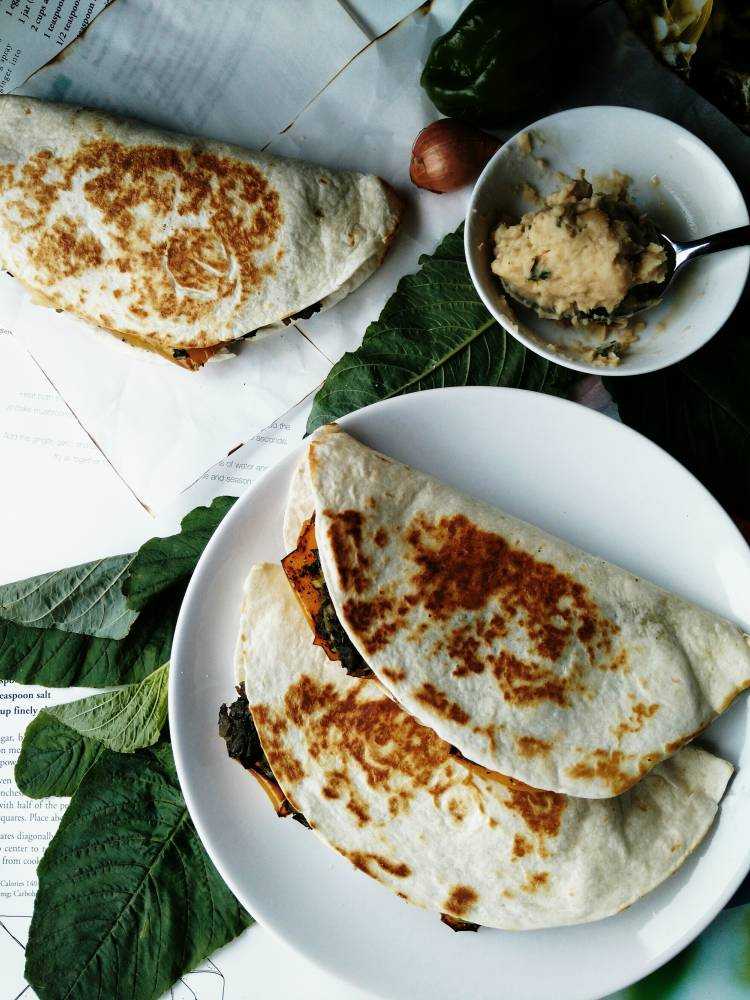BY: EARTHA LOWE
Callaloo is a popular dish served in different variants across the Caribbean. On Sunday mornings in Jamaica, a very vocal gentleman used to visit our neighbourhood with a bucket of callaloo, bok choy, okra and lettuce on his head. He would walk the neighbourhood yelling “callaloo, bok choy (only he pronounced it pop chow), okra and lettuce! callalohoooooo!” In that same order, he yelled those same words, every Sunday morning. Today’s recipe is inspired by my love for this versatile leafy green vegetable.
Callaloo-Stuffed Tortillas with Roasted Sweet Pepper and a Spicy Butter Bean Spread
There are three elements to making this dish that you will enjoy: cooking the callaloo; roasting the bell peppers and blending the spicy butter bean spread. You will also love the use of simple ingredients like green onions, shallots, garlic, apple cider vinegar and scotch bonnet, to make this winning trio.
Cooking the Callaloo When heat is applied to raw callaloo, it shrinks and loses water. To get a half cup of cooked callaloo, one packed cup of raw callaloo must be used. Cooked callaloo is available canned and is just as delicious.
You’ll need
- 10, 7″ round tortillas
- 6 cups tightly packed raw callaloo, chopped, or 3 cups cooked/canned callaloo
- 3 cups butter beans, warmed
- 2 large red or yellow bell peppers
- 2 stalks green onions, chopped
- 3 cloves garlic
- 1 small shallot, roughly chopped
- 1 tablespoon curly parsley
- 1 tablespoon apple cider vinegar
- 3 – 4 teaspoons extra-virgin olive oil
- ½ teaspoon ground allspice
- 1 ½ teaspoons black pepper
- ½ teaspoon sea salt (more to taste)
- 1 scotch bonnet pepper
Directions
Cooking the Callaloo: Heat 1 teaspoon extra-virgin olive oil in a non-stick skillet. Add the green onion, 2 cloves minced garlic to the skillet. Sauté on medium heat for 2 minutes, stirring occasionally. Add the callaloo, season with 1 teaspoon black pepper, allspice, salt (as desired). Cover and let steam for 5 minutes, or until wilted, stirring occasionally. Remove from heat. Drain excess water if any.
Roasting the Bell Peppers: Preheat oven to 350°F. Slice 2 red or yellow bell peppers. Drizzle with a ½ teaspoon extra-virgin olive oil. Season with a ½ teaspoon black pepper. Roast for 10 – 15 minutes. Set aside.
Blending the Spicy Butter Bean Spread: Place 3 cups warmed butter beans in a good food processor. Add 2 tablespoons olive oil, 1 small shallot, roughly chopped, 1 clove garlic, 1 tablespoon curly parsley, 1 tablespoon apple cider vinegar. Blend until smooth or until the spread has reached your desired consistency. Add in scotch bonnet pepper as desired. Continue to blend adding extra olive oil as needed. Salt to taste.
Top The Tortillas: Your callalloo, roasted peppers, and spicy butter bean spread are ready to go! It’s time to load these tasty toppings onto your tortillas. Start with the spread. The tortilla will be folded in half. You can spread the butter bean on one-half of the tortilla, or on the whole tortilla. Add slices of roasted pepper on top of the spread. Top the roasted pepper with callaloo. Fold in half. Place on a hot skillet to toast both sides. Serve hot.
Food category: vegan, vegetarian – go veggie crazy!
Prep and cook time: 45 minutes
Difficulty: moderate
Servings: 4 – 6
Tips:
Kick some sour cream up a notch by mixing it with minced green onion. Serve with these warm tortillas. See more on www.earthacooks.com.

